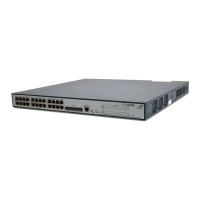231
Item Descri
tion
Trap Interval
Set the minimum interval for sending traps.
With the LLDP trapping function enabled on a port, traps are sent out the port to
advertise the topology changes detected over the trap interval to neighbors. By
tuning this interval, you can prevent excessive traps from being sent when topology
is instable.
Reinit Delay
Set initialization delay for LLDP-enabled ports.
Each time the LLDP operating mode of a port changes, its LLDP protocol state
machine re-initializes. To prevent LLDP from being initialized too frequently at times
of frequent operating mode change, initialization delay is introduced. With this
delay mechanism, a port must wait for the specified interval before it can initialize
LLDP after the LLDP operating mode changes.
Tx Delay
Set LLDPDU transmit delay.
With LLDP enabled, a port advertises LLDPDUs to its neighbors both periodically
and when the local configuration changes. To avoid excessive number of LLDPDUs
caused by frequent local configuration changes, an LLDPDU transmit delay is
introduced. Thus, after sending an LLDPDU, the port must wait for the specified
interval before it can send another one.
IMPORTANT:
LLDPDU transmit delay must be less than the TTL to ensure that the LLDP neighbors can
receive LLDPDUs to update information about the device you are configuring before it
is aged out.
Tx Interval
Set the LLDPDU transmit interval.
IMPORTANT:
If the product of the TTL multiplier and the LLDPDU transmit interval is greater than
65535, the TTL carried in transmitted LLDPDUs takes 65535 seconds. In this case, the
likelihood exists that the LLDPDU transmit interval is greater than TTL. You should
avoid the situation, because the LLDP neighbors will fail to receive LLDPDUs to update
information about the device you are configuring before it is aged out.
Return to LLDP configuration task list.
Displaying LLDP information for a port
Select Network LLDP from the navigation tree to enter the Port Setup tab, as shown in a. In the port list,
click a port name to display its LLDP information at the lower half of the page. The LLDP information is
organized by type and displayed in tabs as shown in a. You can click these tabs to display data you are
interested in.

